Fred Van Lente pays (another) birthday tribute to Gardner Fox — who was born 110 years ago on May 20, 1911 — with a new column concept…
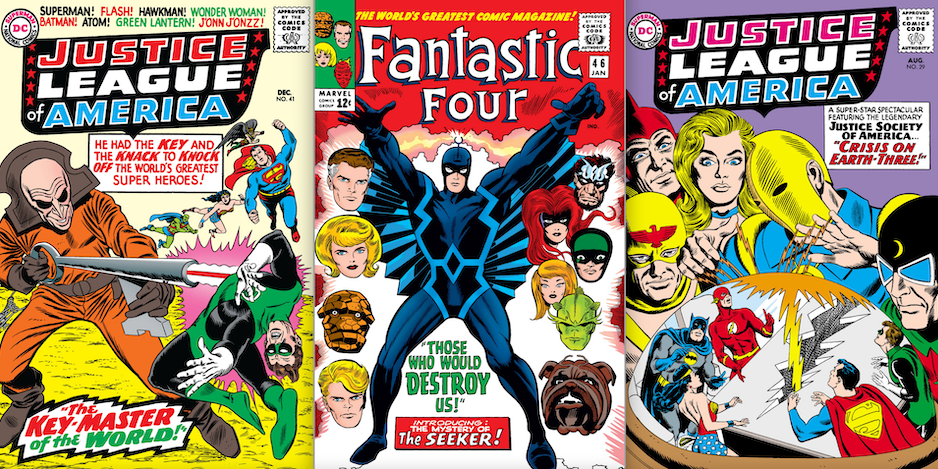
By FRED VAN LENTE
I started out this column intending it to be something completely different, a TOP 13-style survey of Gardner Fox’s seminal run on Justice League of America, one year after I had done the same take on my favorite Fox strip, Adam Strange.
What I said about Adam Strange in that article holds true for Fox’s decade-long run on JLA: You can’t describe any of his stories without sounding like you’re having a stroke. This is back when DC Comics were irrefutably written for children, and Fox’s plots employed the same logic-free improvisation of children’s play.
Yet, as I lacerated my brain cells by devouring Fox and Mike Sekowsky’s run, I couldn’t help but be reminded of JLA’s other claim to comics history fame. Stan Lee told the story many times, most definitively in 1974’s Origin of Marvel Comics, that his boss and cousin-in-law Martin Goodman came into his one office one day and “mentioned that one of the titles published by National Comics [aka DC] seemed to be selling better than most. It was a book called The Justice League of America (sic) and was composed of a team of superheroes. ‘If The Justice League is selling,’ spake he, ‘why don’t we put out a comic book that features a team of superheroes?’”
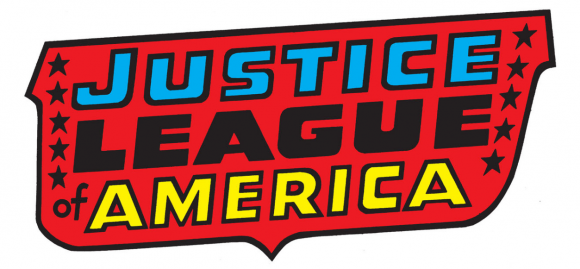
It’s been commonly held by most, including me, that with the debut of Fantastic Four #1, the Marvel Universe began eating DC’s lunch, primarily because of its more “grounded” stories as opposed to the gonzo insanity promoted by creators like, well, Gardner Fox.
So I thought I would do a little thought experiment: Using the invaluable resource that is Mike’s Amazing World of Comics that sorts various titles by pub date (which is how Dan & Co. do their RETRO HOT PICKS column every week) I could find an issue of Justice League of America that came out in a given month and pit it against the comic it allegedly inspired, Fantastic Four, and see how they fared in a direct compare and contrast, over a roughly six-year period.
Enjoy.
—
DECEMBER 1960
Justice League of America #3: The Slave Ship of Space!
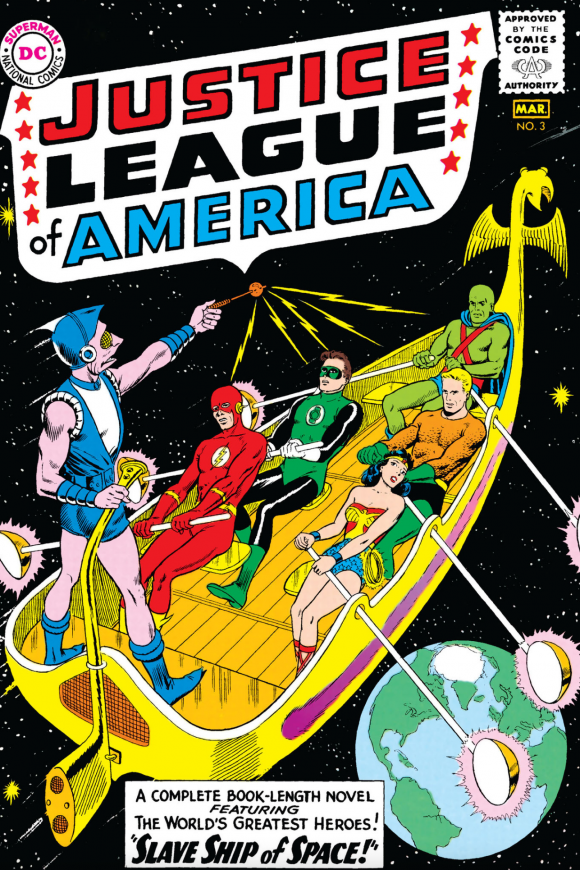
Taking Lee at his word, let’s say he did check out JLA at his boss’ behest. What would he have seen? In this episode, intergalactic douchebag Kanjar Ro, who looks like a fetal shark with Eggos for eyes, has enslaved the JLA with his magic gong and sends them out to battle his despotic rivals in a kind of Hitler vs. Stalin grudge match in space.
For most of Fox’s 60-plus-issue run, the JLA formula is the same: Some threat forces the Leaguers to split up and overcome various challenges that invariably involve their personal Achilles’ heels. In most every JLA issue, we are reminded that Green Lantern’s ring is yellow-intolerant, Martian Manhunter is a pyrophobic, magic turns Superman into Superwuss, and so on.
Gardner Fox was a great idea man, but, let’s face it, characterization was something he had zero interest in. The Leaguers come from a wide variety of professional backgrounds, planets, and/or mythological islands, but in Fox’s hands all sound exactly alike. They are differentiated mostly by color scheme, power set, and Achilles’ heels.
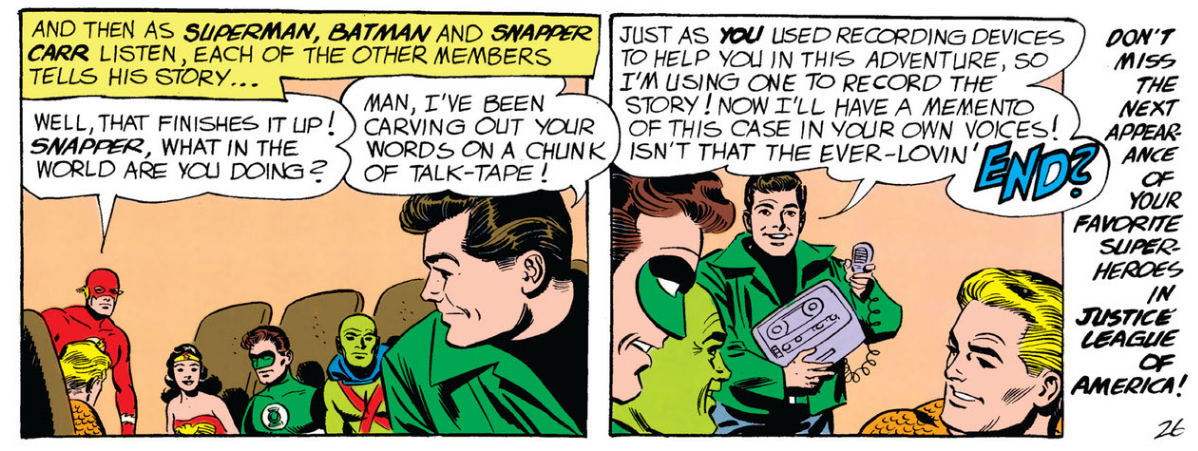
In fact, the only JLA character who sounds unique at all is Snapper Carr, their teenaged sidekick. Despite dressing like Dobie Gillis, Snapper talks like Maynard G. Krebs. He gets his nickname from punctuating his ear-poisoning slang with snaps of his fingers, which I feel like is an affectation that should be avoided by everyone except 1970s street pimps for their own personal safety.
Though I wonder: Despite the fact that Fox’s strained attempt at hipness is very much of the “How Do You Do, Fellow Kids” variety, did Lee read Snapper and discover he was allowed to do this kind of thing in a superhero comic? Lee scripted way, way more teen and romance comics than superheroes pre-FF… and I can’t help but think Snapper’s very existence made Lee realize he could mix these genres together, and come up with the self-deprecating, jokey tone that made him famous.
In other words, Dear Reader, I ask you with hushed awe, barely believing it myself, DID SNAPPER CARR CREATE THE MARVEL UNIVERSE?!?
WINNER: JLA (by default)
—
AUGUST 1961
Justice League of America #7: The Cosmic Funhouse!
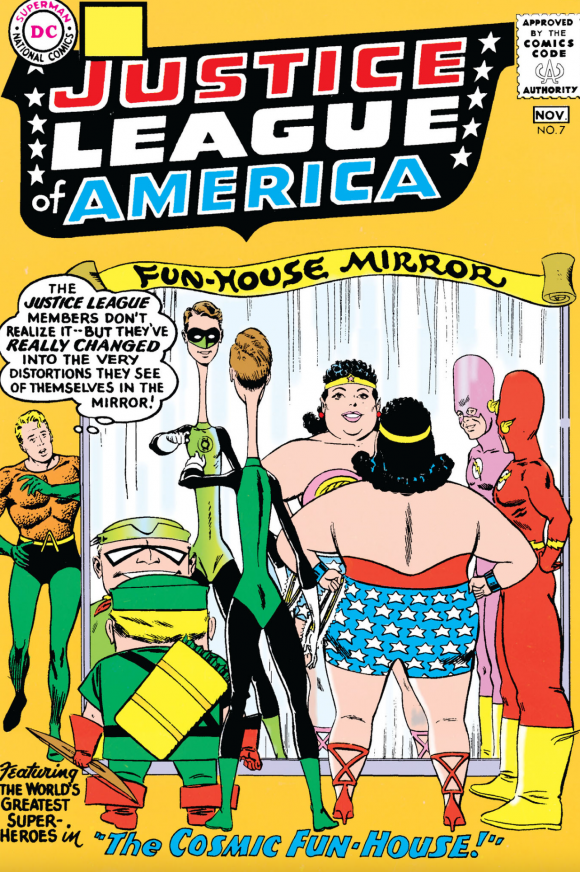
Eight months later, aliens set up a sinister carnival in Happy Harbor, Rhode Island (which, likely not coincidentally, is the exact same set-up of a particularly trippy Grant Morrison/Richard Case Doom Patrol arc), ensnaring first Snapper Carr, then his best friends, the world’s greatest superheroes. Why they do this is so complicated I tried typing out the explanation three different times before becoming convinced I was providing evidence against myself in my eventual commitment hearing, so I gave up. Their space-mirrors transform the JLA into squat, big-headed, fat, skinny-necked versions of themselves, just as depicted on the cover. Yes, it is bananas.
—
Fantastic Four #1: The Fantastic Four!
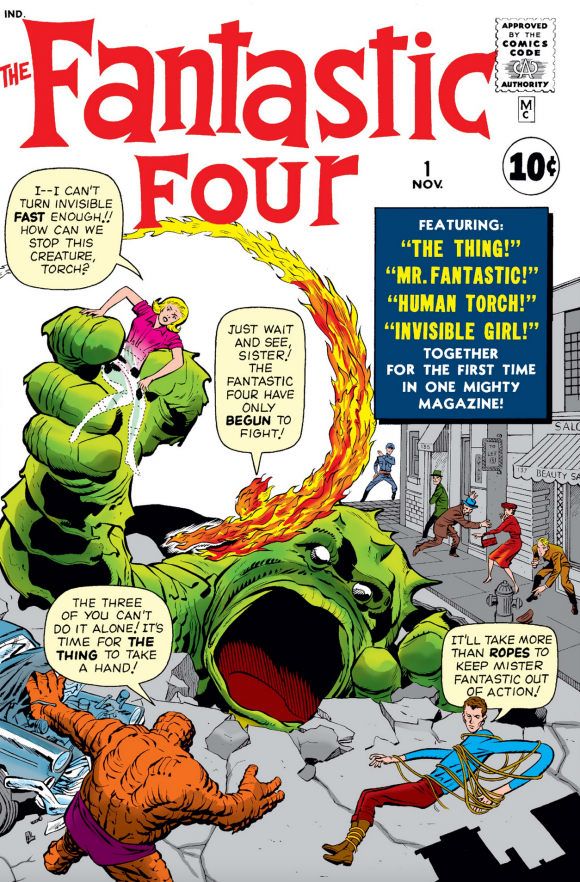
And in the same month that the Justice League is barely escaping from the Cosmic Funhouse with their BMIs intact, the Marvel Age of Comics begins. The most striking thing about this comic is how utterly unlike Justice League of America it is. For one thing, as opposed to the Leaguers, nobody knows who these characters are, so we start out with very down-to-earth vignettes that introduce them, usually by terrifying normies with their weird powers.
Then, we get a four-page flashback, and then they go off to fight the Mole Man, a strangely sympathetic incel villain. He has a bunch of monsters from previous Marvel/Atlas kaiju books at his beck and call that the Human Torch seals inside Monster Island with a molten mud slide. Compared to other Silver Age books (and soon, issues of this title) it’s almost documentarian, telling its story in a no-frills, just-the-facts-ma’am fashion that only helps ground its “fantastical” elements. No alien funhouse mirrors here, no siree.
Yes, Johnny Storm is vaguely Snapper Carr-esque, in that he is a typical comic book teenager obsessed with cars and girls, yet does not have a speech pattern that makes me want to murder him. Was Martin Goodman annoyed at how not-JLA this all was as the pages came to him? Did Martin Goodman actually read Justice League of America to tell the difference? Once FF became a sales hit, it’s unlikely he cared.
WINNER: FF
—
OCTOBER 1962
Justice League of America #16: The Cavern of Deadly Spheres!
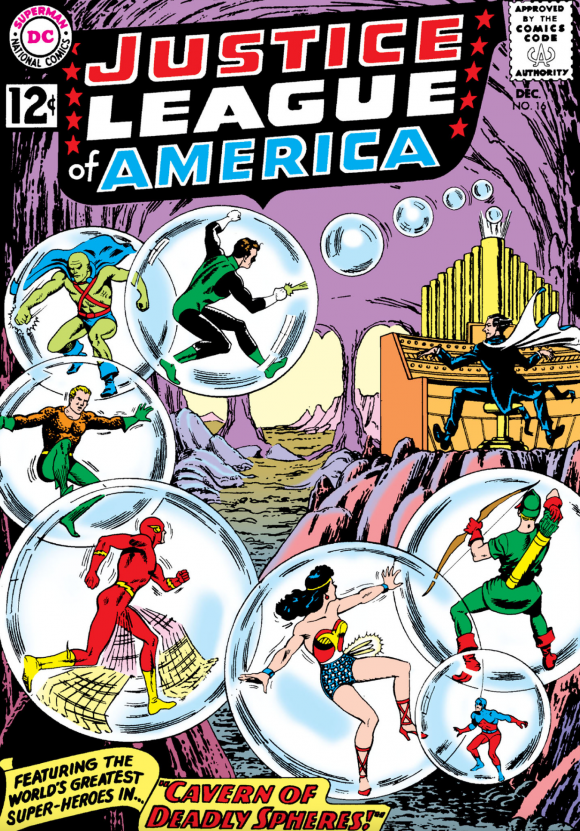
Oh, nos! Leaguers all around the country are being compelled by music to dance… dance! Wonder Woman jigs, Green Arrow marches, Atom does an old Russian dance, Martian Manhunter does a war dance! Should I go on?
OK, I will! Batman does not his signature Batusi, but rather something called the “Acrobatic Dance!” Green Lantern whirls like a dervish! Superman shufflefoots! Flash does the dubiously named “back and wing!” Aquaman does a jig too, because clearly Fox is running out of entries in his Dance Thesaurus!
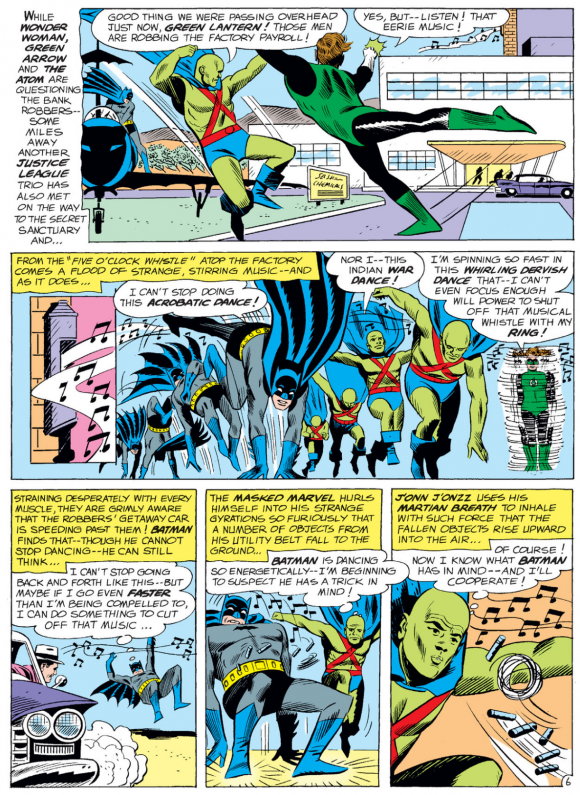
The criminal composer behind all this insanity is none other than the Maestro, who lives in a cave with a giant organ and nothing else. The giant super-organ spits out giant bubbles that trap the JLAers and forces them to dance… forever! He then blows up the cave, burying the League inside forever…
… at which point Snapper Carr (of course) reveals that this is an imaginary story written and drawn by one of their fans that the League is reading in their headquarters. Far out, Daddy-o. The Leaguers then make themselves feel better by coming up with scenarios in which they would defeat the evil organist with escapes even more preposterous than the deathtraps.
—
Fantastic Four #10: The Return of Dr. Doom!
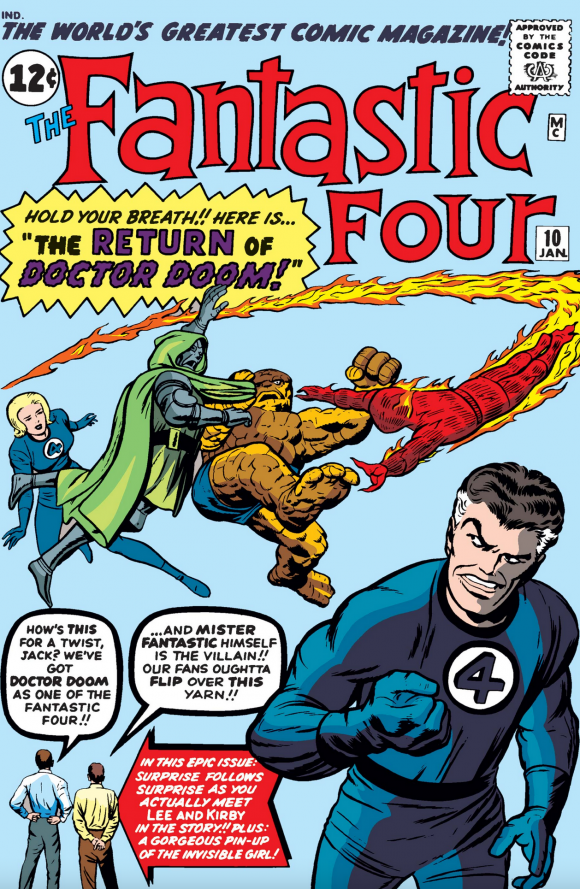
FF quickly veers from the Dragnet-style monster-punching of its first issue straight into Silver Age Crazytown. In this issue, Doctor Doom crashes the Marvel offices and tells Stan Lee and Jack Kirby that he was rescued from deep space by bubble-headed aliens named [DEEP SIGH] the Ovoids who taught him how to swap bodies with people. So of course he switches minds with Reed Richards. He tries to convince the FF to murder Dr. Doom, who is now Reed. And it would have worked, too, if not for that meddling Alicia Masters, whose eyes cannot betray her, so she instantly recognizes that Reed is actually Doom and vice versa.
Does a DC Imaginary Story trump a Marvel meta-meet-the-creators tale? The answer is between you and your gods.
WINNER: DRAW
—
JUNE 1964
Justice League of America #29: Crisis on Earth-Three!
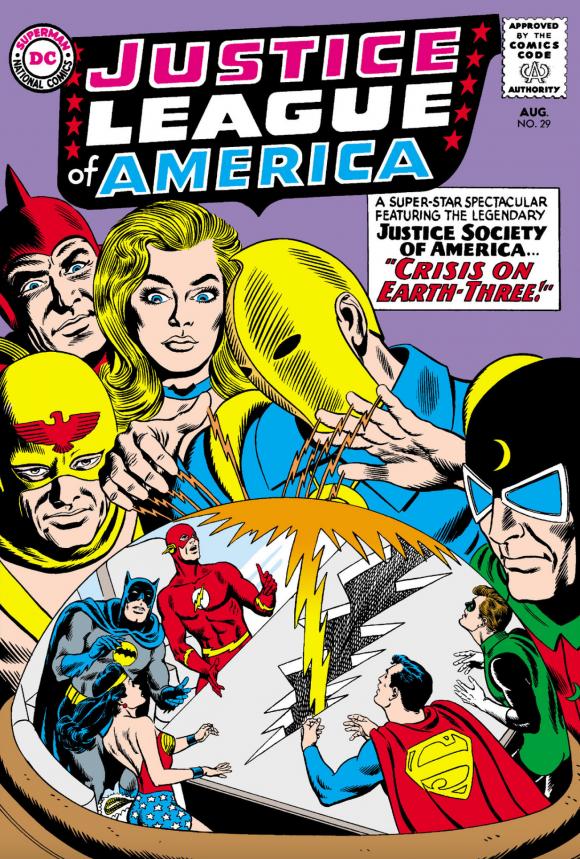
I’d argue that the two-parter that introduces the Crime Syndicate of America is the single best story of the Fox/Sekowsky run. Here, Fox’s total disinterest in characterization actually works in his favor, because the CSA invades Earth-Two to wail the crap out of the Justice Society basically out of sheer boredom, and the bland matter-of-factness of their villainy makes the whole thing even more compelling.
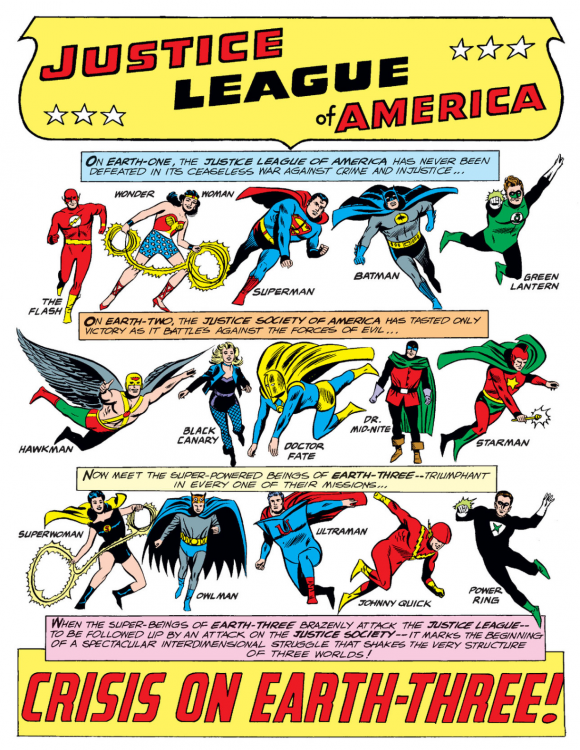
JLA does the evil-counterparts thing three years before Star Trek does it with “Mirror, Mirror” with the obvious difference that unlike in Trek and later iterations of the DC Multiverse, the evil supers of Earth-Three are most emphatically not supposed to be direct analogues of their Earth-One counterparts. (Which makes sense, since, this early in the run, there are few direct analogues on Earth-Two’s Justice Society.) Ultraman’s face, to take just one example, is completely different from Superman’s. And Kryptonite makes him stronger than weaker. How awesome is that?
—
Fantastic Four #30: The Dreaded Diablo!
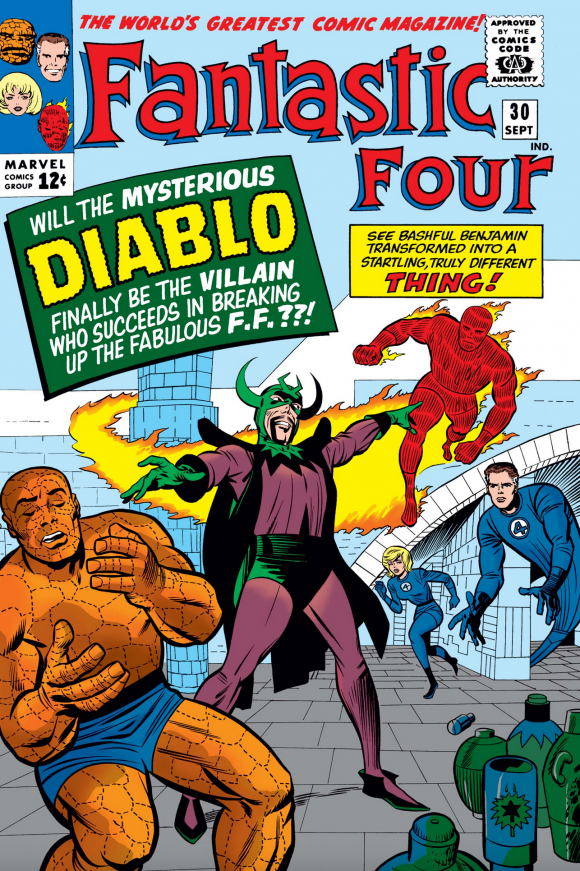
(The numbering of FF outpaces JLA for the simple reason that FF is a monthly and JLA isn’t.) The FF is vacationing in beautiful Transylvania, as one does, where the Thing is hoodooed into unleashing legendarily mustachioed alchemist Diablo. He promises to turn Ben human in exchange for beating the piss out of the FF, which is something Ben has been doing off-and-on for the last 30 issues anyway, so it’s an easy sell.
So while the set-up here is as ridiculous as any other Silver Age joint, I’d argue here is where we start see a serious divergence between the two titles and the FF starts to pull away from its alleged inspiration. The Thing ultimately realizes his mistake, not out of the goodness of his heart, but because the ruthless Diablo double-crosses him. This is a story rooted in character-based conflict and not interdimensional shenanigans. There’s no accounting for taste, but if I’m teaching How to Write, this is the example I use.
That said, though, the CSA is super-rad.
WINNER: JLA
—
OCTOBER 1965
Justice League of America #41: The Key-Master of the World!
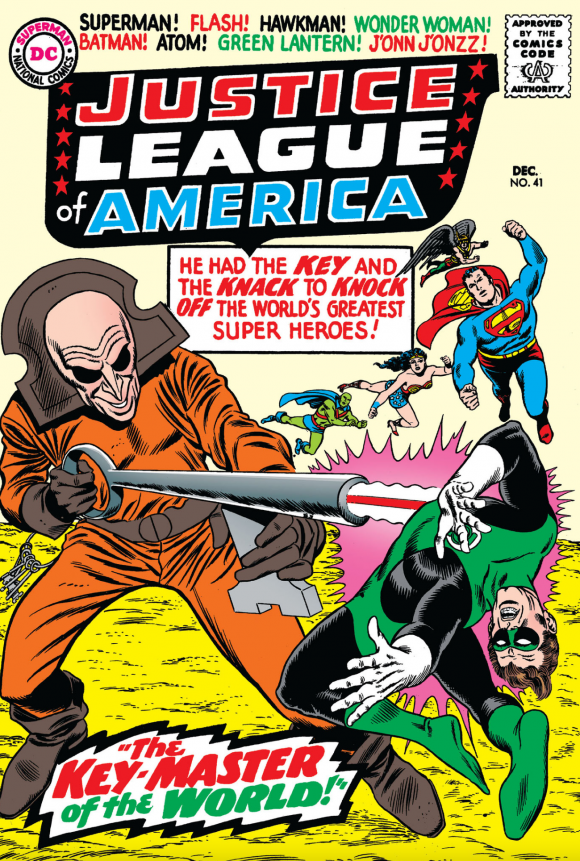
The Key is the sort of trippy character that, if Gardner Fox hadn’t come up with him, Grant Morrison would have. An expert in “psycho-chemicals” that lets him control other’s brains via a vast computer grid controlled by literal keys, this locksmith-themed baddie spikes the JLA punchbowl with goofy juice thanks to perennially useful idiot Snapper Carr. This not only lets him dupe the Leaguers into disbanding and blowing up their own headquarters, it also blocks our heroes’ brains from registering the existence of his awesomely designed Key Men goons. And it would have worked, too, if not for that meddling Hawkgirl, who wasn’t invited to the meeting where everybody got roofied, so she can see through the Key’s scheme just fine. And you thought sexism was bad!
—
Fantastic Four #46: Those Who Would Destroy Us!
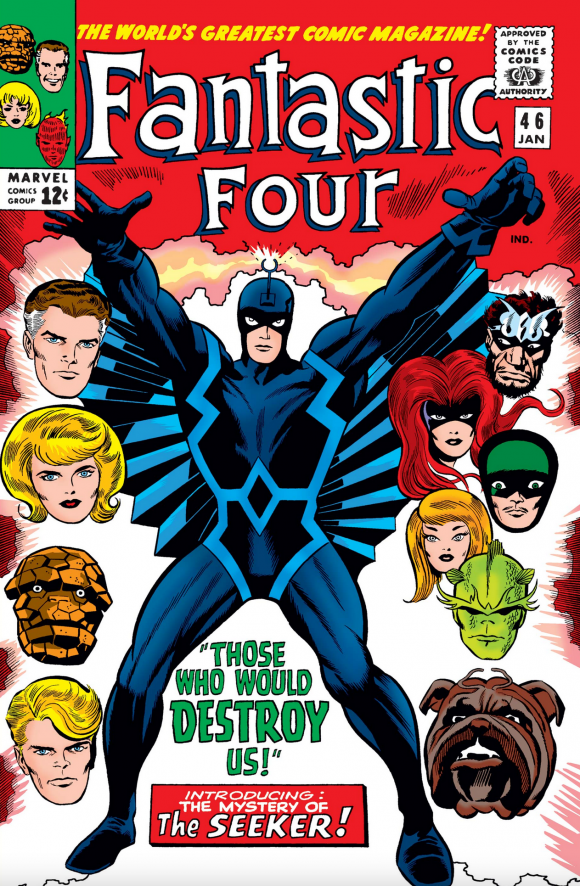
Unlike JLA, which has been entirely done-in-ones and two-parters so far, Lee and Kirby have being doing a slow-burn roll-out of the Inhumans for a while now (arguably ever since Medusa’s introduction way back in #36), culminating in this issue, where Black Bolt throws down with the FF to prevent them from tipping off their location to the current, crazed ruler of the Great Refuge. The Inhumans also have a giant teleporting bulldog, which I feel like may be the most Gardner Foxian (totally a word) that Jack Kirby has ever been.
So here we see that, four years into their respective runs (astoundingly, still with the same creative teams), FF and JLA are playing two completely different ballgames. At the end of their issue, the Leaguers arrest the Key, who threatens a vague vengeance at some indeterminate point in the future. While in the Marvel Universe, when Lockjaw teleports the Inhuman Royal Family away from the FF, our heroes realize they have blundered into a much bigger conflict than they ever suspected. (“Medusa wasn’t some sort of freak — but rather part of a strange unsuspected race,” gasps Sue Storm.) The Inhumans storyline then continues for an unprecedented fourth issue before rolling into a little thing called The Galactus Trilogy. While JLA excels at world building, FF is as good at it, while also providing resonant emotional connective tissue that increases reader investment even more.
WINNER: LOCKJAW
—
APRIL 1966
Justice League of America #45: The Super-Struggle Against Shaggy Man!
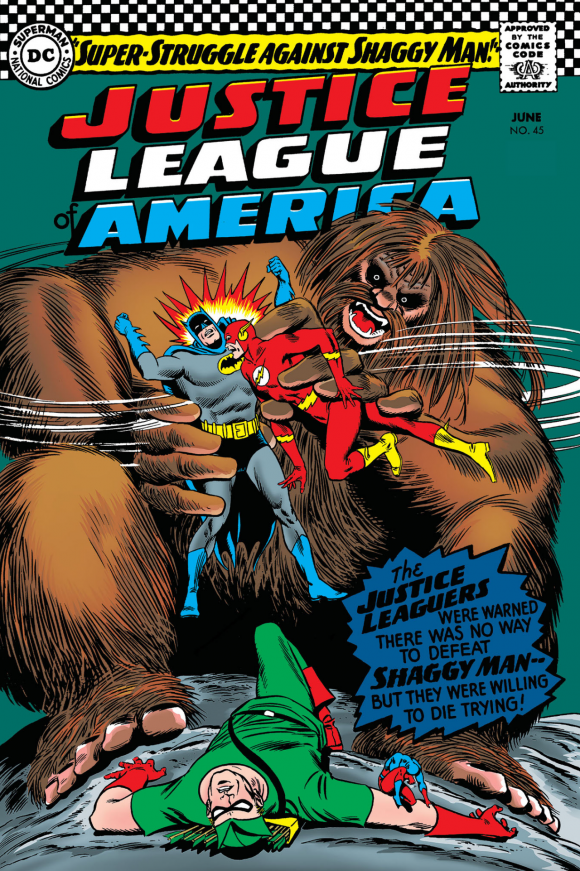
There’s nothing about the inexplicably pissed-off super-yeti known as Shaggy Man that isn’t completely amazing. An inventor creates an invulnerable organic plasticine in the hope of making replacement limbs and organs. But when he tries to create a facsimile of a person with this “plastalloy,” the hair follicles become super powerful too (yes, really) and it grows hair all over its synthetic body and he decides to trash everything he sees like he’s a coked-up rock star and the world is his hotel room.
And then, get this, the understandably disturbed scientist writes a letter to the Justice League — not a frantic radio message, he doesn’t invent the internet, I mean a paper letter with a stamp — and if you think this response is maybe inadequate to the threat, the story proves you right: The plane carrying the letter crashes and it’s not until two years later that the League gets the warning.
Because the JLA are hands-on with their fan mail, they investigate just as the Shagster bursts out of the prison his creator caught him in and proceeds to beat them like pancake batter. Fortunately, the Shaggy Man will attack literally anything in its path, so the Leaguers grow a second self-loathing Shaggy Man and the two of them can keep wailing on each other for all eternity. And you thought being a superhero was hard!
—
Fantastic Four #52: The Black Panther!
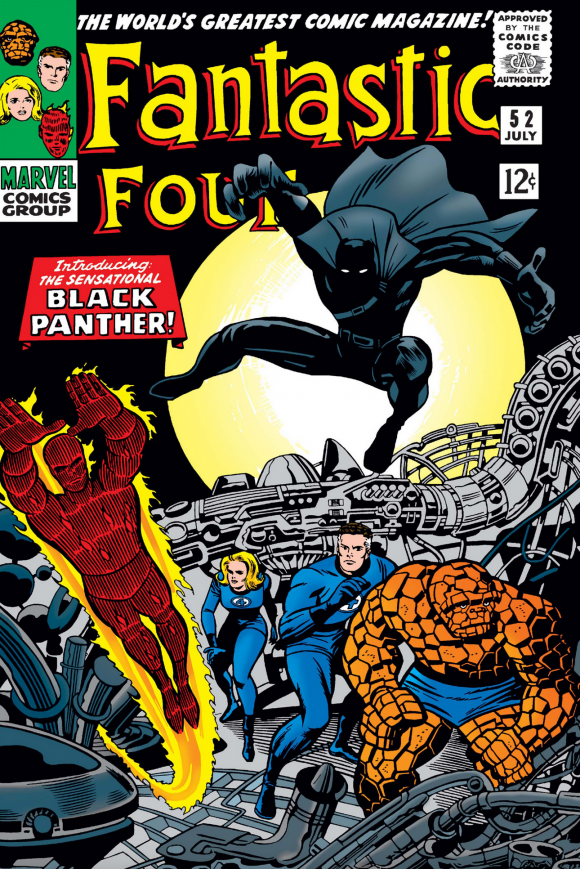
And now the divergence between these two titles is complete. At the same time JLA is dealing in plastic super-yetis and postal snafus, Lee and Kirby are introducing the first important Black superhero in American comics history, T’Challa, and his Afro-Futurist utopia of Wakanda. While Fantastic Four may have started out with Ovoid body swapping and Transylvanian vacations, it evolved significantly over the first five years of its run, while Justice League of America pretty much stayed where it started, rooted in bananas high concepts and the world’s greatest superheroes being brought low by spiked party punch and alien funhouse mirrors.
It doesn’t take a super-genius to figure out where this evolution came from; by all accounts, by this time Stan Lee had ceded almost all of the plotting duties on FF to Jack Kirby, who was weaned on the science fiction and fantasy pulps Gardner Fox cut his eyeteeth writing (and would continue to write after he left comics). Kirby was the student who surpassed the master: He was a better plotter and idea man than Fox (and Stan Lee) and he and Lee actually cared about characterization, so they both wrote better dialogue.
Fox wouldn’t surrender writing duties on JLA until 1969, and it’s telling that the person who took over, the late, great Denny O’Neil, was one of the hipper, younger creators DC was bringing in to refresh its stable in face of intense competition from, that’s right, Marvel Comics.
OVERALL WINNER: FF
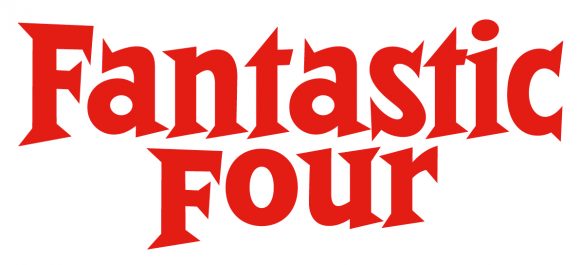
—
Well, that was an interesting experiment, hope you dug it as much as I did. If you have any ideas for month-by-month title competitions for future columns, let me know in the comments!
—
MORE From FRED VAN LENTE
— The TOP 13 Gardner Fox ADAM STRANGE Stories — RANKED. Click here.
— The Sad, Confused Legacy of STAN LEE. Click here.
—
13th Dimension columnist Fred Van Lente is a comics writer, historian and playwright, who has chronicled the relationship between Stan Lee and Jack Kirby in the play-turned-podcast King Kirby, written with Fred’s wife Crystal Skillman.

May 20, 2021
This has been a very enjoyable article. 🙂
May 20, 2021
This was a lot of fun to read, thank you! As for suggestions for future match-ups, the first one that pops to mind is early-80s comparisons between X-Men and Teen Titans. I am an X-Men fan, but suspect they would have an uphill battle, having just lost John Byrne right when Wolfman and Perez were getting started. Still, your month-by-month formula should yield some interesting observations as Claremont’s rotating artists brought some cool dynamics to the table while the Titans steamrolled on with more and more complex developments.
May 20, 2021
Ooh, that X-Men vs Teen Titans is a genius idea, thank ye kindly (Dan G you seeing this)
May 21, 2021
I concur!
May 22, 2021
Funny thing is that the Wolfman/Perez Teen Titans was DC’s answer as it were to Claremount’s X-Men. In some bizarre way, I enjoyed Claremount’s over-scripting but not Wolfman’s. An inexplicable mystery.
And speaking of which, or not, I loved Claremount and Simonson’s X-Men/Titans book. Perfect little done-in-one.
May 22, 2021
The funny thing about Gardner Fox is that, as a comics writer, there were essentially two. The lionized one is someone who would co-plot with Julie (B.O.) Schwartz and whom B.O. would heavily rewrite. Great question: Your average Fox script for Schwartz: Whose fingerprints are predominantly on the story, Fox or Schwartz’s? (For those who care about this kind of stuff, IIRC, John Broome, an actual Schwartz buddy, unlike Fox, had his scripts pass through with no editing to speak of.)
As to the Fox/Schwartz JLA, the tank started to run empty long before Fox left the book (and company in the late 60s purge). Like, a couple of years. Last few years were awful but for the summer JSA team-ups.
The second Fox was a boring hack. No non-Schwartz Fox story comes to mind that was actually enjoyable.
As for the inker on those JLA covers in the post, Bernard Sachs: Another Schwartz buddy. Dunno quite the line but it was said that not a single page wasn’t made worse by Sachs’ inking. Google artist Neke Carson’s claim to fame and, uh, how Carson did a series of paintings is how I sort of envision Sachs’ inking, at least figuratively speaking. Gotta say I did enjoy the Sekowsky/Sachs art when a wee tot although maybe I responding more to the pencils despite the inks.
The moral here, though, is that as a rule, Schwartz skewed towards hiring his buddies for writing as a rule. And some of them, let’s say, are weren’t quite the best. I’m still traumatized by the tsunami of mediocrity of the end of Schwartz’s run on Batman scripted by buddy David Vern
May 22, 2021
Wow! What a great read. This blog came up randomly on my Google news feed and I’m really glad it did. I’ve actually been a fan of Van Lente since Comic Book Comics.
I’ve always been puzzled about Fox’s (and, frankly, all of Silver Age DC’s) complete lack of characterization. I mean, it’s not like characters having feelings and interpersonal drama was a new concept in the 1960s. I really can’t figure out if if it was a lack of talent, lack of interest, or pure stubbornness that kept DC so bland for so long.
I mean, at first you can argue that interpersonal drama in a superhero comic book could seem as bizarre and pointless concept as giving Tony the Tiger a tragic backstory. But after years of Marvel capturing the zeitgeist you would think DC would have caught on. So again, was it that DC writers just didn’t have the talent, or because churning out another color of kryptonite wouldn’t interrupt their three martini lunch? Or was it some dogged company determination that characterization was just some flower child fad? Even if DC wanted to target a younger audience, it seems like that younger audience still preferred Marvel.
I just wonder if their are any oral histories or interviews that shed some light on this.
May 23, 2021
Great read, and though I was reading them as a boy in the ’70’s, those musty books in friend’s basements let me “time travel” to the “Silver Age”, onwards, and what a ride it was. Thanks for this, and can’t wait for your next installment.